1.Magnetism and Gauss’s Law
- Books Name
- Physics Book Part l and ll
- Publication
- Grow Career Publication
- Course
- CBSE Class 12
- Subject
- Physics
Chapter 5: Magnetism and Matter
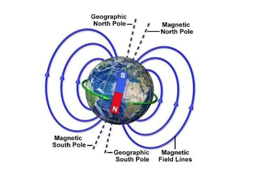
THE BAR MAGNET
A bar magnet is a rectangular piece of an object, made up of iron, steel or any other ferromagnetic substance or ferromagnetic composite, that shows permanent magnetic properties. It has two poles, a north and a south pole such that when suspended freely, the magnet aligns itself so that the northern pole points towards the magnetic north pole of the earth.
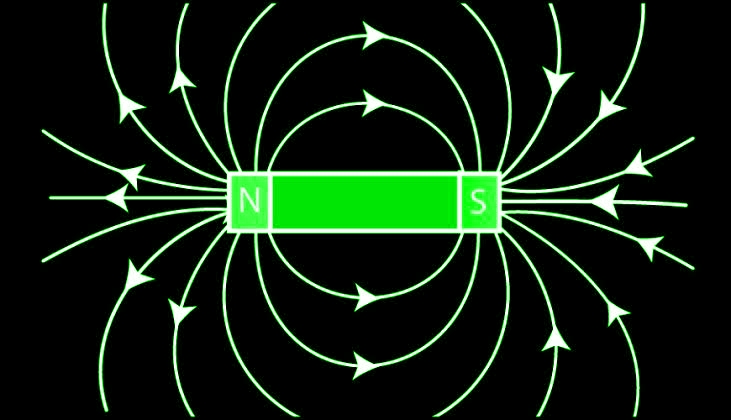
Types of Bar Magnet
There are two types of bar magnet:
- Cylindrical bar magnet: A cylindrical rod is also known as rod magnets that have a thickness equal to larger than the diameter enabling high magnetism property.
- Rectangular bar magnet: Rectangular bar magnets find applications in manufacturing and engineering industries as they have magnetic strength and field greater than the other magnets.
Bar magnet as an equivalent solenoid
A solenoid is a coil with a length greater than its diameter and is a type of electromagnet to produce controlled magnetic fields by passing an electric current through it.
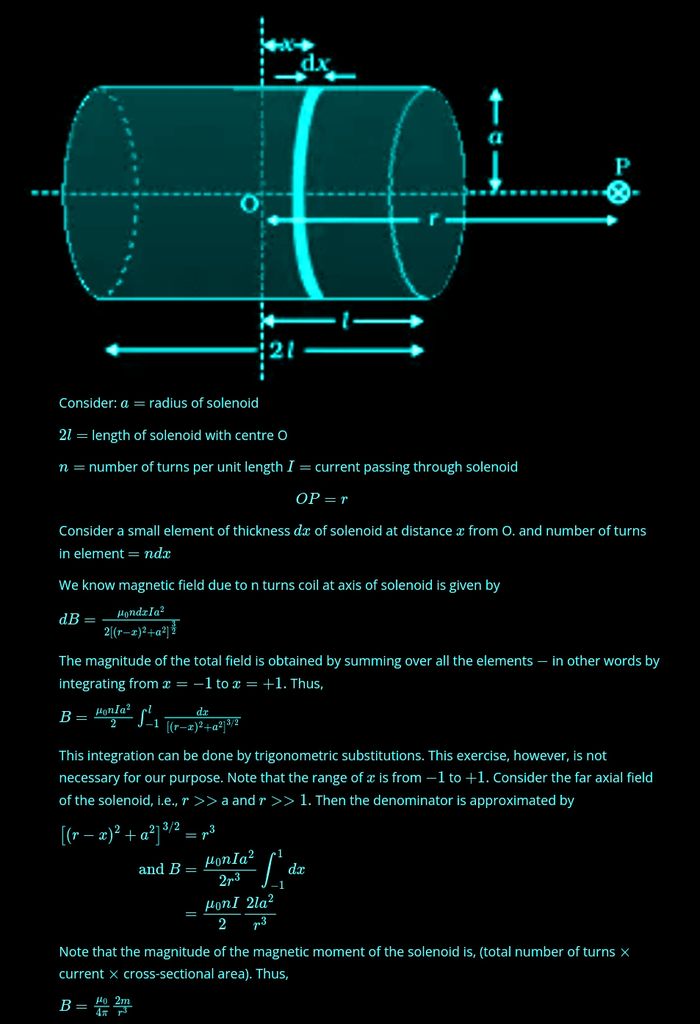
The dipole in a uniform magnetic field
Take a compass with known value of magnetic moment m and moment of Intertia I . Allow the needle to oscillate in a magnetic field of value B.
The torque on the needle is given by
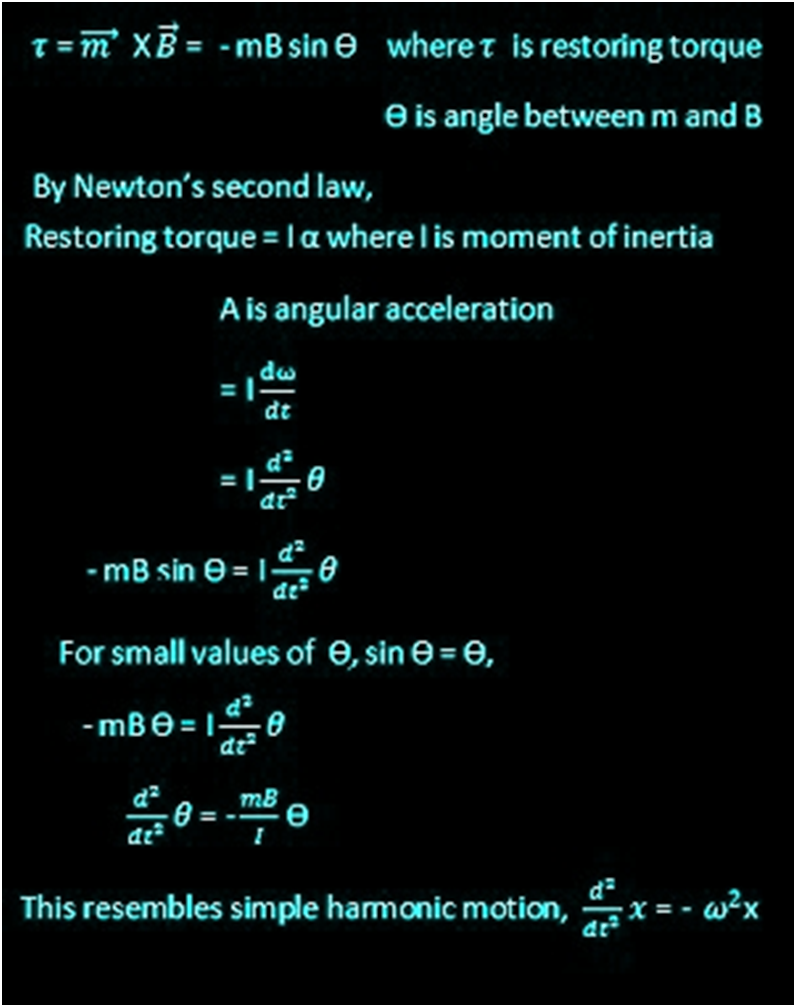
MAGNETISM AND GAUSS’S LAW
Gauss' Law for magnetism applies to the magnetic flux through a closed surface. In this case the area vector points out from the surface.
Because magnetic field lines are continuous loops, all closed surfaces have as many magnetic field lines going in as coming out. Hence, the net magnetic flux through a closed surface is zero.
Net flux = ∫ B • dA = 0
∫E⋅dA=Q/ε0
Where,
- E is the electric field vector
- Q is the enclosed electric charge
- ε0 is the electric permittivity of free space
- A is the outward pointing normal area vector
1.Magnetism and Gauss’s Law
- Books Name
- Physics by Anshu Physics Book
- Publication
- Madhava Publications
- Course
- CBSE Class 12
- Subject
- Physics
Introduction
Magnetic phenomena are universal in nature. In the last chapter, we learned that moving charges or electric currents produce magnetic fields. In this chapter, we will take a look at magnetism as a subject on its own.
The word Magnet is derived from the name of an island in Greece called Magnesia where magnetic ores deposits were found. The directional properties of the magnets have been known since ancient times. A freely suspended magnet points itself in a north-south direction.
Magnetism
Some of the commonly known ideas regarding magnetism are:
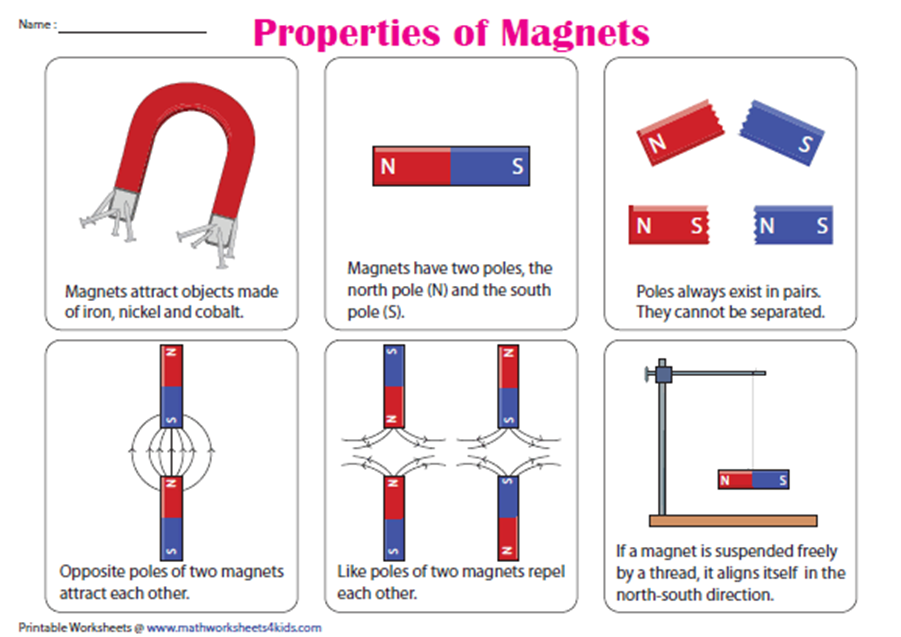
- The earth behaves like a magnet with the magnetic field pointing approximately from the geographical south to the north.
- Directive Property: When a bar magnet is freely suspended. It points in the north-south direction. The tip which points toward the geographical north is called the north pole of the bar magnet. And the tip which points toward the geographical south is called the south pole of the bar magnet.
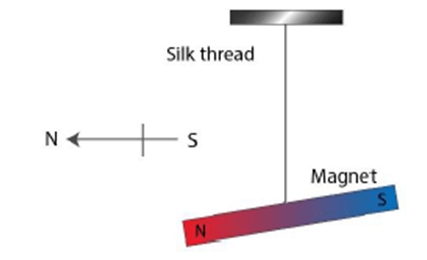
- Like poles of the magnet repel each other and unlike poles attract each other.
- Attractive property: A magnet attracts small pieces of iron, cobalt and nickel etc.
- Magnetic poles always exist in pairs: Magnetic monopoles do not exist. We cannot isolate the north or south pole of the magnet. If we try to isolate two poles by breaking the magnet in the middle, each broken part is found to be a magnet with N and S poles.
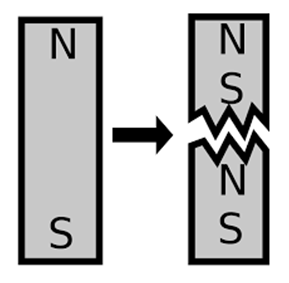
- Magnetic Induction: It is possible to make magnets out of iron and its alloys.
The Bar magnet
A bar magnet is a bar of circular or rectangular cross-section magnet.

Let’s first discuss some important definitions related to magnetism:
- Magnetic field: The space around the magnet within which its influence can be experienced is called the magnetic field.
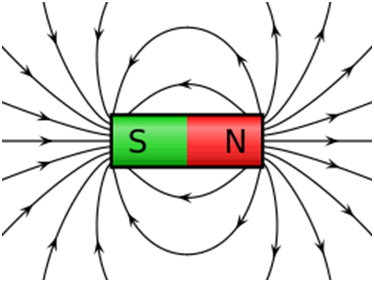
- Uniform magnetic field: A magnetic field in a region is said to be uniform if it has the same magnitude and direction at all points of that region.
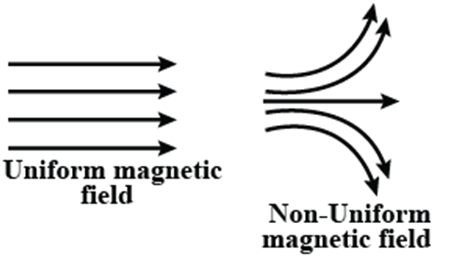
- Magnetic poles: There are regions of apparently concentrated magnetic strength in a magnet where the attraction is maximum.
- Magnetic axis: The line passing through the poles of a magnet is called the magnetic axis of the magnet.
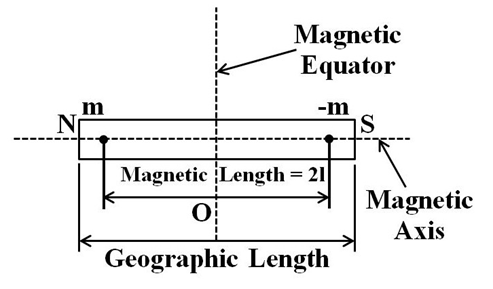
- Magnetic equator: The line passing through the center of the magnet and at right angles to the magnetic axis is called the magnetic equator of the magnet.
- Magnetic length: The distance between the two poles of a magnet is called the magnetic length of the magnet. It is slightly less than the geometrical length of the magnet.
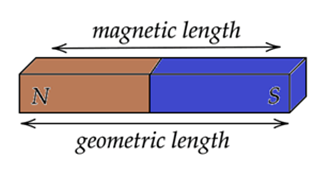
Magnetic dipole and magnetic dipole moment
In electrostatics, we had electric dipoles and electric dipole moments. In the same way in Magnetostatics we have magnetic dipoles and magnetic dipole moments.
An arrangement of two equal and opposite magnetic poles separated by a small distance is called a magnetic dipole.
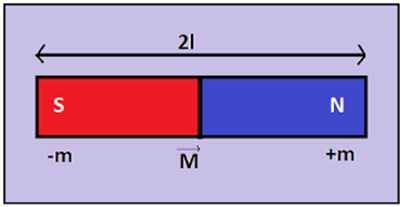
Every bar magnet is a magnetic dipole. A current-carrying loop behaves as a magnetic dipole. Even an atom acts as a magnetic dipole due to the circulatory motion of electrons around its nucleus.
Magnetic dipole moment: The magnetic dipole moment of a magnetic dipole is defined as the product of its pole strength and magnetic length. It is a vector quantity, directed from the south pole to the north pole.
Where m= pole strength.
2L is the length of a magnet.
M= magnetic dipole moment
Magnetic Field Lines
Michael Faraday introduces a hypothetical concept of magnetic field lines to represent a magnetic field visually.
Magnetic field lines may be defined as the curve the tangent to which at any point gives the direction of the magnetic field at that point.
Properties of magnetic field
- Magnetic lines of force are closed curves that start in the air from the N-pole to the S-pole and return to the N-pole through the interior of the magnet.
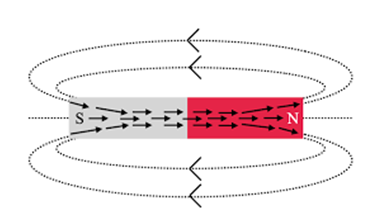
- The lines of forces never cross each other. If they do so, that would mean there are two directions of the magnetic field at that point of intersection which is impossible.
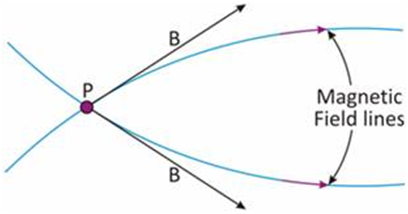
- The lines of forces have a tendency to contract lengthwise and expand sidewise. This explains attraction between unlike poles and repulsion between like poles.
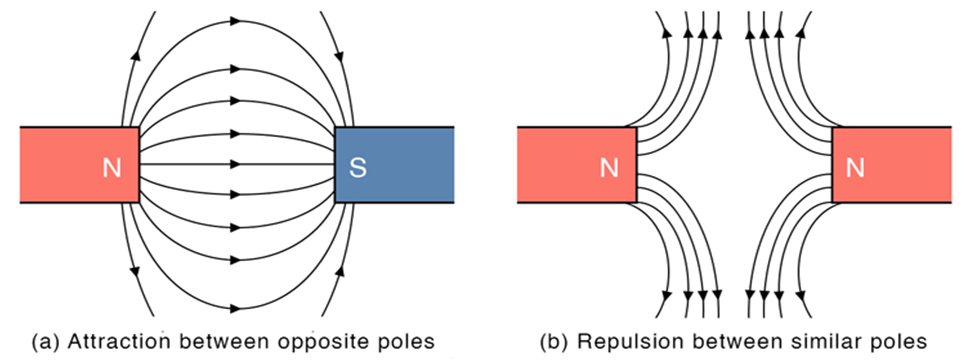
- The relative closeness of the lines of forces gives the measure of the strength of the magnetic field which is maximum at the poles.
Bar magnet as an equivalent solenoid
When a current is passed through a solenoid, it behaves like a bar magnet. Some observations of similar behavior are as follows :
- A current-carrying solenoid suspended freely always comes to rest in a north-south direction.
- Two current-carrying solenoids exhibit mutual attraction and repulsion when brought closer to one another.
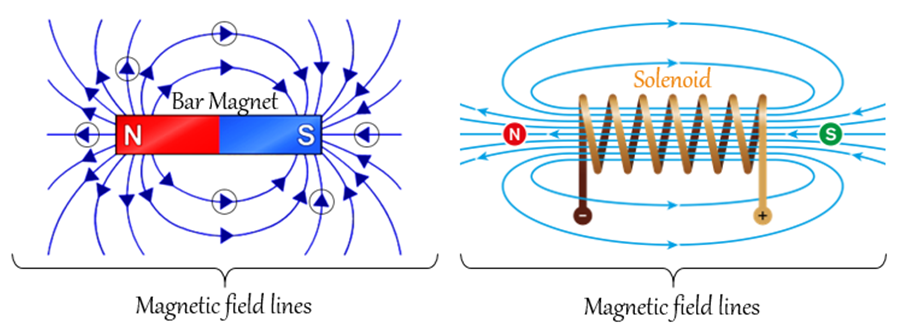
- The pattern of lines of forces of a bar magnet and current-carrying solenoid is exactly similar. Thus a bar magnet and current-carrying solenoid produce a similar magnetic field.
Gauss’s law in Magnetism
Gauss’s Law for magnetism is applied to the magnetic flux through a closed surface. In this case, the area vector points out from the surface. Because magnetic field lines are continuous loops, all closed surfaces have as many magnetic field lines going in as coming out and hence net magnetic flux through a closed surface is zero.
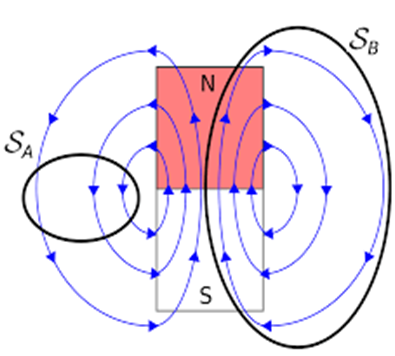
Gauss’s Law in magnetism states that the surface integral of a magnetic field over a closed surface is always zero. The net magnetic flux through a closed surface is zero.
Mathematically it is written in integral form as:
![]()
Differential form of Gauss’s law in Magnetism
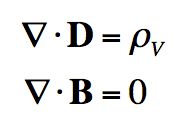
Consequences of Gauss’s Law :
- Gauss’s law indicated that there are no sources or the sink of the magnetic field inside a closed surface. Hence isolated magnetic poles called monopoles do not exist.
- The most elementary magnetic element is a magnetic dipole or a current loop. All magnetic phenomena can be explained in terms of an arrangement of magnetic dipoles or current loops.
- If a number of field lines enter a closed surface then an equal number of lines of forces must leave that surface.
The Earth’s Magnetism
Earth is a powerful natural magnet. Its magnetic field is present everywhere near the earth’s surface. The branch of physics that deals with the study of earth’s magnetism is called terrestrial magnetism or geomagnetism.
Evidence in support of earth’s magnetism:
- A freely suspended magnetic needle comes to rest roughly in a north-south direction. This suggests that the earth behaves as a large magnet with its south pole lying somewhere near the geographic north pole and its north pole lying somewhere near the geographical south pole.
- An iron bar buried in the earth becomes a weak magnet. Magnetism is induced by the earth’s magnetic field.
- Existence of neutral points near a bar magnet indicated the presence of the earth’s magnetic field.
Origin of the earth’s magnetism
If earth behaves like a natural magnet. The question will arise: what is the origin of earth’s magnetism?. Many scientists have given theories about the cause of the earth’s magnetism.
- William Gilbert suggested that magnetism is due to the presence of magnetic material at its center, which could be a permanent magnet.
- Prof Blackett suggests that the earth’s magnetism is due to the rotation of the earth about its own axis.
- Sir E. Bullard said that there are large deposits of ferromagnetic materials like iron, cobalt etc in the core of the earth in molten form. When the earth rotates about its axis, the circulating ions in the highly conducting liquid region of the earth’s core form current loops and hence produce a magnetic field.
Some terms related to earth’s magnetism
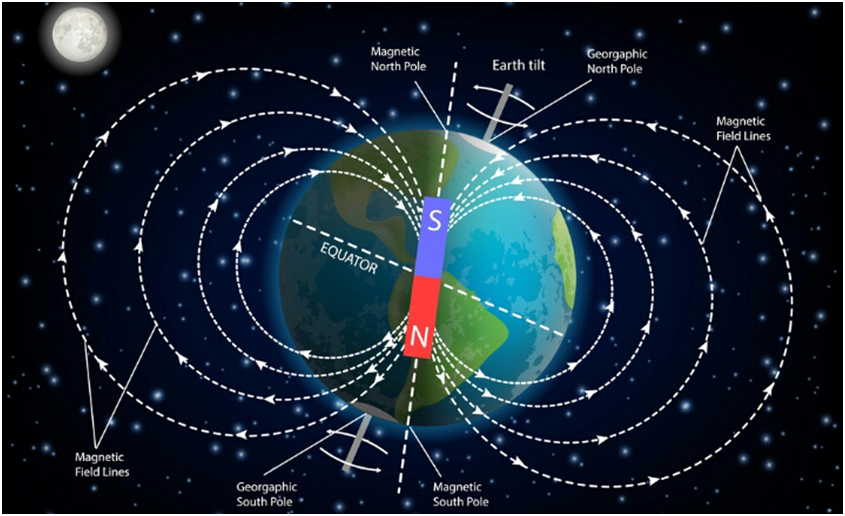
Geographica axis: The straight line passing through the geographical north and south directions of the earth. It is the axis of rotation of the earth.
Magnetic axis: The straight line passing through the magnetic north and south poles of the earth is called its magnetic axis.
Magnetic equator: It is the great circle on the earth perpendicular to the magnetic axis.
Magnetic meridian: The vertical plane passing through the magnetic axis of a freely suspended small magnet. The earth’s magnetic field acts in the direction of the magnetic meridian.
Geographical meridian: The vertical plane passing through the geographical north and south pole.
Element of Earth’s magnetic field
The earth’s magnetic field at any point can be explained completely by three parameters which are called elements of earth’s magnetism. These elements are Magnetic declination, magnetic inclination and the horizontal component of the earth’s magnetic field.
- Magnetic declination: The angle between the geographical meridian and the magnetic meridian at a place is called the magnetic declination (α) at that point.
It arises because the magnetic axis of the earth does not coincide with the geographical axis.

- Magnetic inclination or angle of dip: The angle made by the earth’s total magnetic field B with the horizontal direction in the magnetic meridian is called the angle of dip (δ) at any place.
The angle of dip is different at different places on earth. It is zero at the magnetic equator and 90 degrees at the poles. At all other places, it varies between 0 to 90.
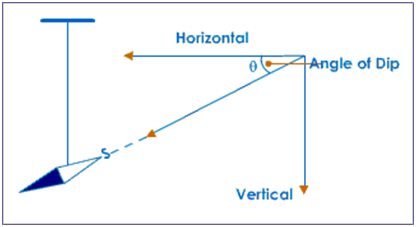
- Horizontal component of the earth’s magnetic field. It is the component of the earth’s total magnetic field B in the horizontal direction in the magnetic meridian.
It is given by the formula
2.Magnetisation and Magnetic Intensity
- Books Name
- Physics Book Part l and ll
- Publication
- Grow Career Publication
- Course
- CBSE Class 12
- Subject
- Physics
MAGNETISATION AND MAGNETIC INTENSITY
Mathematically,

Let us take a solenoid with n turns per unit length and the current passing through it be given by I, then the magnetic field in the interior of the solenoid can be given as,
![]()
Now, if we fill the interior with the solenoid with a material of non-zero magnetization, the field inside the solenoid must be greater than before. The net magnetic field B inside the solenoid
![]()
Where Bm gives the field contributed by the core material. Here, Bm is proportional to the magnetization of the material, M
![]()
Here, µ0 is the constant of permeability of a vacuum.
Let us now discuss another concept here, the magnetic intensity of a material. The magnetic intensity of a material can be given as,
![]()
From this equation, we see that the total magnetic field can also be defined as,
![]()
Here, the magnetic field due to the external factors such as the current in the solenoid is given as H and that due to the nature of the core is given by M.
![]()
![]()
Here, the term µr is termed as the relative magnetic permeability of a material, which is analogous to the dielectric constants in the case of electrostatics. We define the magnetic permeability as,
![]()
MAGNETIC PROPERTIES OF MATERIALS
Magnetic materials are classified into three categories, based on the behaviour of materials in the magnetic field. The three types of materials are diamagnetic, paramagnetic and ferromagnetic.
Intensity of magnetisation (I)
The electrons circulating around the nucleus have a magnetic moment. When the material is not magnetised the magnetic dipole moment sum up to zero.
Coercivity
The coercivity of a material is the ability to withstand the external magnetic field without becoming demagnetised.
Retentivity
The ability of a material to retain or resist magnetization is called retentivity.
Magnetic Field (H)
The magnetic field produced only by the electric current flowing in a solenoid is called the magnetic intensity.
Magnetic susceptibility
When a material is placed in an external magnetic field, the material gets magnetised. For a small magnetising field, the intensity of magnetisation (I) acquired by the material is directly proportional to the magnetic field (H).
I ∝ H
I = χmH , χm is the susceptibility of the material
PERMANENT MAGNETS AND ELECTROMAGNETS
Permanent Magnet
1. Flexible Magnets: They are utilised in refrigerator door seals. Rubber polymers, plastics, and magnetic powders can all be used to create them.
2. NdFeB (Neodymium Iron Boron Magnet): These are rare earth magnets. It’s fairly simple to oxidise. It’s a high-priced substance. It’s frequently used in jewellery making, bookbinding, and other crafts.
3. A permanent magnet’s magnetic field can only be created below a particular temperature. As a result, these magnets aren’t suitable for use in hot-device applications.
4. Hard drives, motors, vehicles, generators, TVs, phones, headphones, speakers, transducers, and sensors all require permanent magnets. A magnet’s most common purpose is to attract other magnetic things, but it also serves a variety of tasks in electrical devices.
5. The majority of speakers use a permanent magnet that interacts with a wire coil (an electromagnet, really). The audio signal travels along the cable and causes the speaker to move. The speaker creates sound by moving air.
Electromagnet
1. Resistant electromagnets: This sort of magnet uses copper wires to create a magnetic field. The magnetic field is created when the copper wire is twisted around a piece of iron and an electric current is sent through the copper wire. The stronger the field, the more copper wires are twisted.
2. Hybrid electromagnets: They are a mix of the two types of electromagnets mentioned above, resistive and superconductor electromagnets.
3. Electromagnets require a constant current source. Due to numerous variables such as ohmic heating, inductive voltage spikes, core losses, coil coupling, and so on, this may impact the magnets and their field at some point in the future.
2.Magnetisation and Magnetic Intensity
- Books Name
- Physics by Anshu Physics Book
- Publication
- Madhava Publications
- Course
- CBSE Class 12
- Subject
- Physics
Magnetization and magnetic intensity.
Magnetization, also called magnetic polarization, is a vector quantity that gives the measure of the density of permanent or induced dipole moment in a given magnetic material.
We have seen that electrons in an atom have a magnetic moment. In bulk, these magnetic moments add up vectorially and they give a net magnetic moment.
We define magnetization M of a sample to be equal to its net magnetic moment per unit volume.

Consider a long current-carrying solenoid, Magnetic field inside the solenoid is given by
![]()
When the interior is filled with magnetic material with non-zero magnetization. Then field inside the solenoid B will be greater than B0
B = B0 + Bm, Where Bm is a field contributed by the magnetic cores. Bm is proportional to the magnetization M.
![]()
Now introducing another vector field H called the magnetic intensity, which is defined by
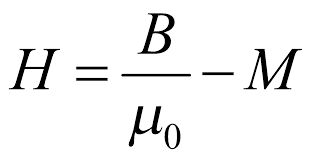
![]()
Magnetization M is proportional to magnetic intensity H.
![]()
Where χ is a dimensionless quantity and called magnetic susceptibility.
Magnetic materials
Materials that are attracted by the magnet are called magnetic materials. And materials that are not attracted to a magnet are called non-magnetic materials.
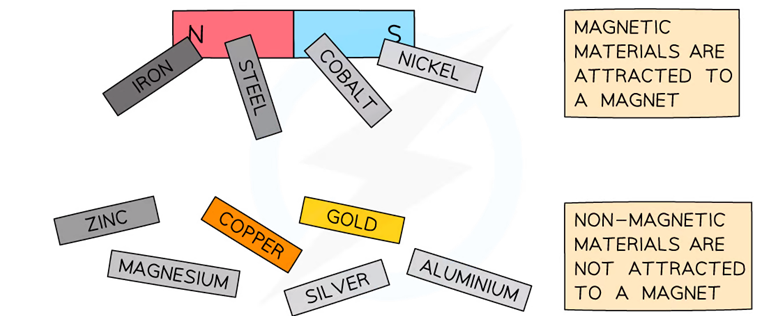
Classification of Magnetic materials
Magnetic materials are classified into the following types. In this chapter, we will discuss diamagnetic, paramagnetic and ferromagnetic materials in detail.
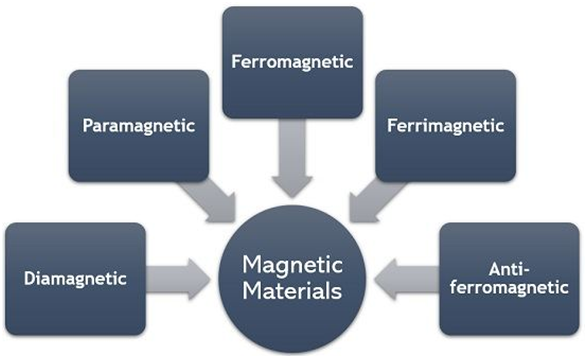
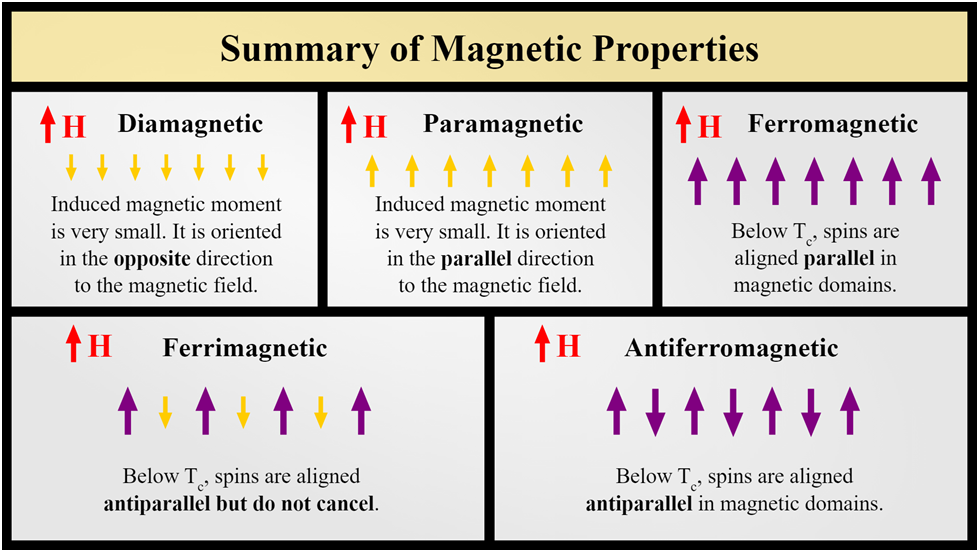
Diamagnetism
- Materials that have a tendency to move from the stronger to the weaker part of the external magnetic field.
- These materials are weakly repelled by the magnetic field.
Cause of Diamagnetism
Electrons revolve around the nucleus in an orbit possessing orbital angular momentum. The orbiting electrons are equivalent to the current-carrying loop and thus possess a magnetic moment. In diamagnetic materials, the resultant magnetic moment of the atom is zero.
When the magnetic field is applied, those electrons having orbital magnetic moments in the same direction slow down and those in opposite directions speed up in accordance with Lenz’s law.
Thus the substance develops a net magnetic moment in the direction opposite to the applied field and is hence repelled by the field.
Paramagnetism
- Paramagnetic substances are those which get weakly magnetized when placed in an external magnetic field.
- They have a tendency to move from a region of the weaker magnetic field to a stronger magnetic field, these are weakly attracted by the external field.
Cause of paramagnetism
The individual atoms (ions or molecules) of a paramagnetic material possess magnetic moments of their own. In the absence of external B, these magnetic moments are oriented in a random direction and hence net magnetic moment is zero. When we apply an external magnetic field, the individual magnetic dipoles orient themselves in the direction of the magnetic field and hence get weakly magnetized
Ferromagnetism
- Ferromagnetic materials are those which get strongly magnetized when placed in an external magnetic field.
- Ferromagnetic materials have a strong tendency to move from a region of the weaker magnetic field to a stronger field when placed in an external magnetic field.
- These materials got strongly attracted by the external magnetic field.
Cause of ferromagnetism
In ferromagnetic materials, individual atoms are associated with large magnetic moments. The magnetic moments of the neighboring atoms interact with each other and align themselves spontaneously in a common direction over microscopic regions called domains.
In a ferromagnetic material in the unmagnetized state, atomic dipoles in small regions called domains are aligned in the same direction. The domain exhibits a net magnetic moment even in the absence of an external magnetizing field.
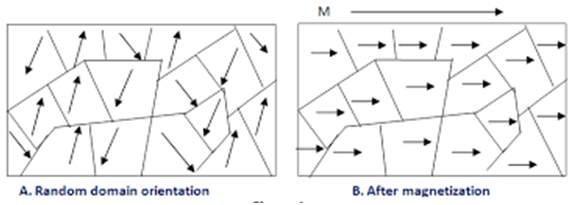
However, the magnetic moment of the neighboring domains are oriented in opposite directions and they cancel out and therefore the net magnetic moment of the material is zero.
On applying an external magnetic field these domains all align themselves in the direction of the applied field. In this way, the material is strongly magnetized in a direction parallel to the magnetizing field.
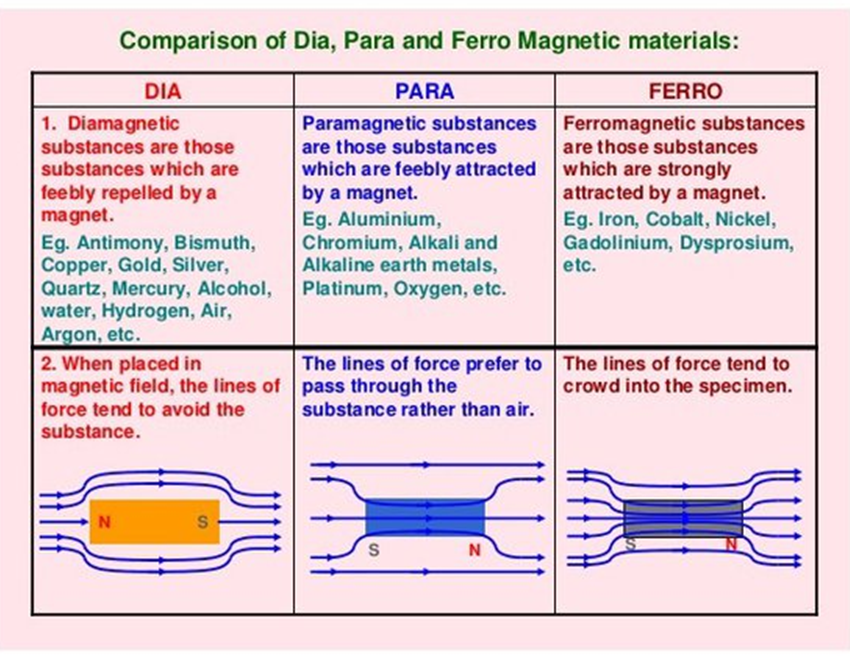
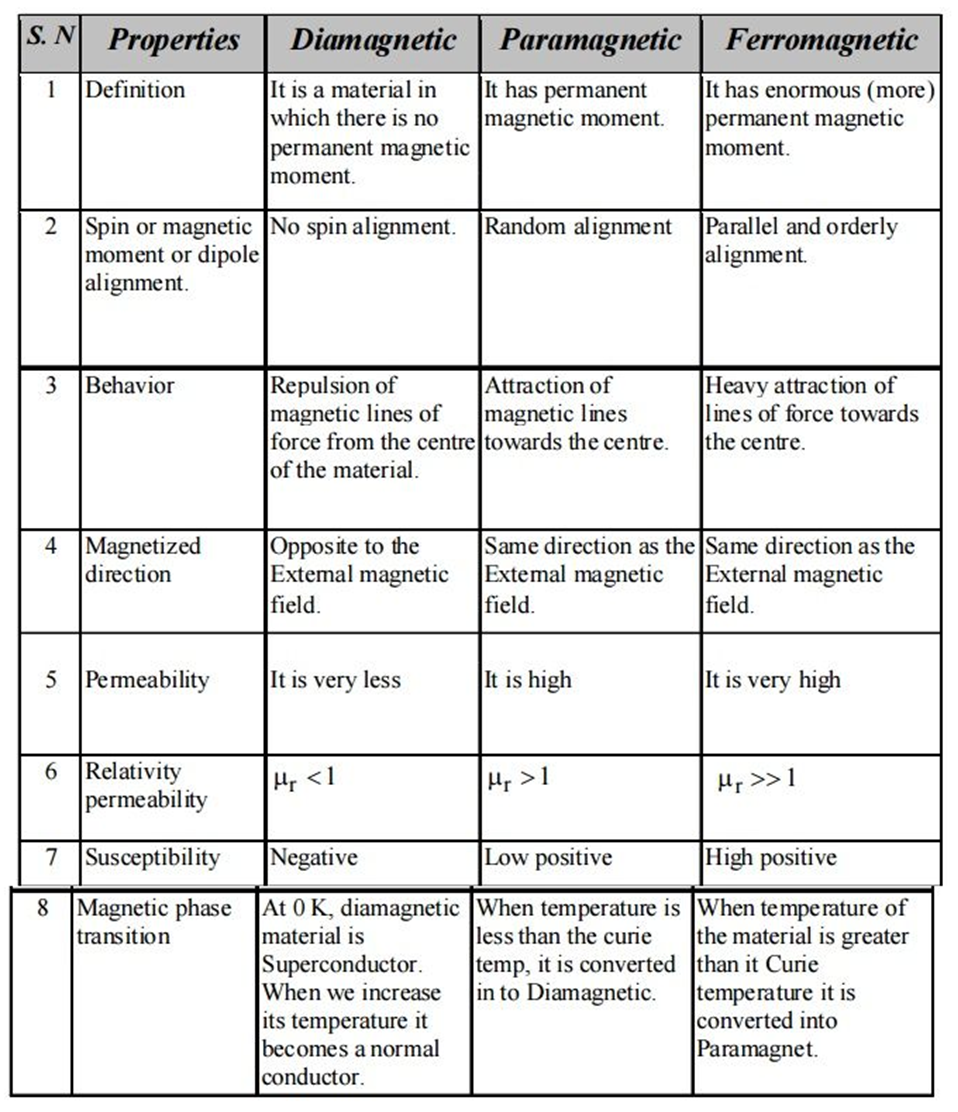

Hysteresis
When a ferromagnetic sample is placed in a magnetizing field, the sample gets magnetized by induction. As the magnetizing field intensity H carries, the magnetic induction B does not vary linearly with H.
The figure given below shows the variation of magnetic induction B with magnetizing field intensity H.
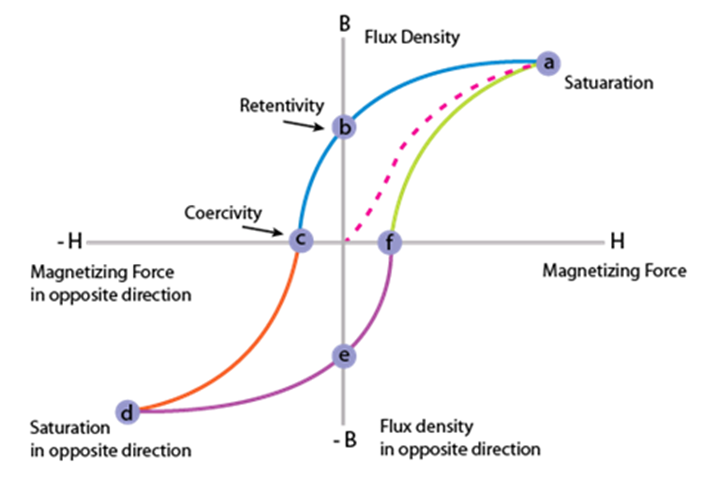
- The origin represents the initial unmagnetized state of a ferromagnetic sample. As the magnetizing field intensity H increases, the magnetic induction B first gradually increases and attains a constant value.
- Now if the magnetizing field intensity H is gradually decreased to zero, B decreases but along a new path AB. The sample is not demagnetized even when the magnetizing field has been removed.
- The magnetic induction left behind in the sample after the magnetizing field has been removed is called residual magnetism or retentivity.
- To reduce the magnetism to zero, the field H id gradually increases in the reverse direction, the induction B decreases and becomes zero at a value of H= OC.
- The value of reverse magnetizing field intensity H required for the residual magnetism of a sample to become zero is called coercivity of the sample.
A study of the hysteresis loop provides us with information about retentivity, coercivity and hysteresis loss of magnetic. This helps in the proper selection of material for designing cores of transformers and electromagnets and making permanent magnets.
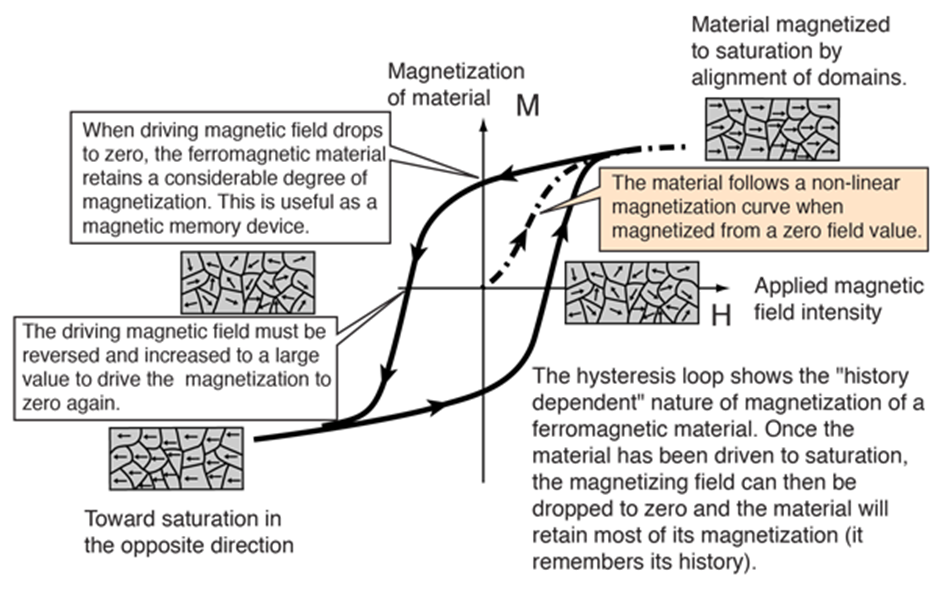
Soft ferromagnetic materials
These are the ferromagnetic materials in which the magnetization disappears on the removal of the external magnetization field. Such materials have narrow hysteresis loops.
Example: soft iron.
Hard ferromagnetic material
These are the ferromagnetic materials that retain magnetization even after the removal of the external magnetizing field.
Example: Steel, lodestone etc.
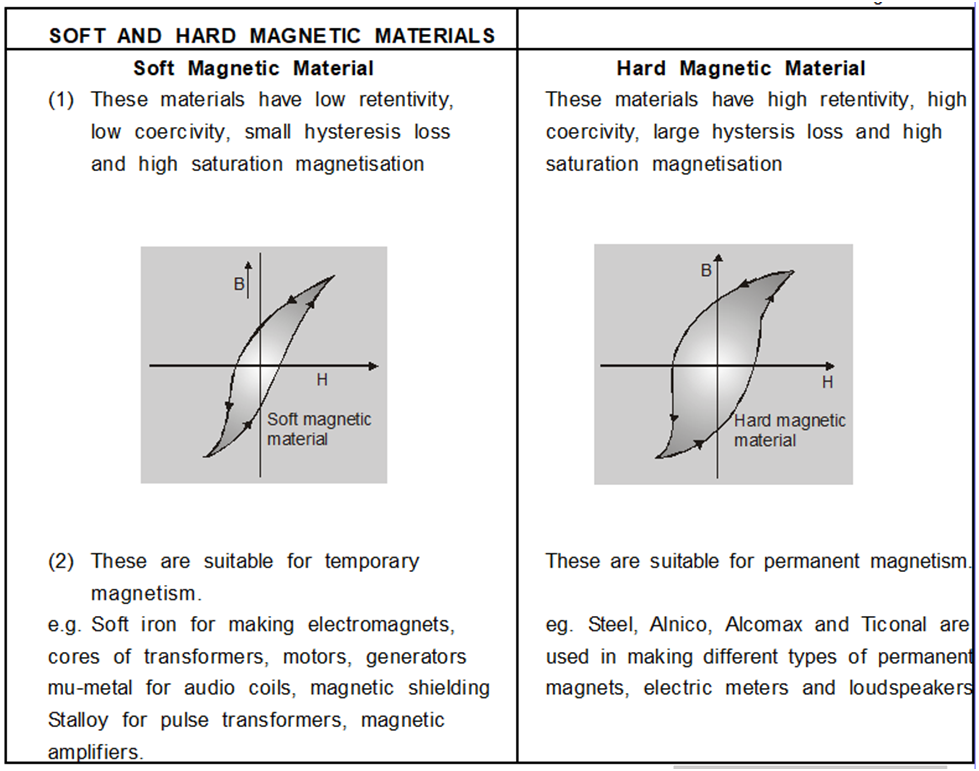
Permanent magnets and electromagnets
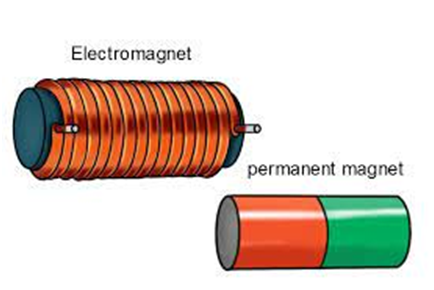
Permanent magnets
Substances which at room temperature retain their ferromagnetic property for a long period of time are called permanent magnets.
Methods of making permanent magnet :
- One can hold an iron rod in a north-south direction and hammer it repeatedly.
- One can also hold a steel rod and stroke it with one end of a bar magnet a large number of times , always in the same sense to make permanent magnets.
- An efficient way to make a permanent magnet is to place a ferromagnetic rod in a solenoid and pass a current. The magnetic field of the solenoid magnetizes the rod.
Desired property of a material to make permanent magnets
Hysteresis curve allows us to select suitable material for the permanent magnet.
- Material should have high retentivity so that the magnet is strong.
- Material should have high coercivity so that the magnetization is not erased by any stray magnetic field, temperature fluctuations etc.
- Steel is the favorable choice of material for a permanent magnet, Other suitable materials for permanent magnet are alnico, cobalt steel and ticonal.
Electromagnets
Electromagnets are the type of magnets where a magnetic field is produced by electric current. It is made up of a coil of wire which acts as a magnet when an electric current passes through it.
- An electromagnet only displays magnetic properties when an electric current is applied to it.
- The strength of an electromagnet can be adjusted by the amount of electric current allowed to flow into it.
- Cores of electromagnets are made of ferromagnetic material which have high permeability and low retentivity. Soft iron is a suitable material for electromagnets.
Application of the electromagnets
- It is used in generators and motors, which are necessary for the conversion of mechanical energy into electrical energy.
- Electric buzzers and bells.
- Headphones and loudspeakers use electromagnets.
- Data storage devices like VCR’s, tape recorders, hard discs etc.
- MRI machines also used electromagnets.

 Grow Career Publication
Grow Career Publication
 Madhava Publications
Madhava Publications
